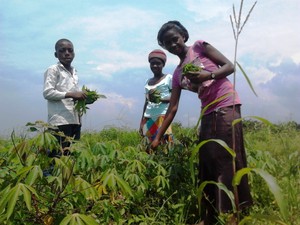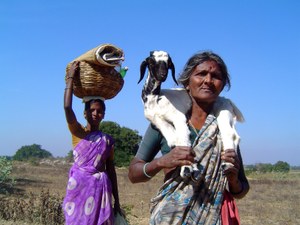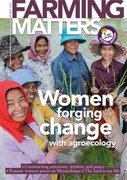Around the world, women forge change in their communities using agroecological approaches. Yet, surprisingly little has been written about this subject. This issue of Farming Matters shows how women can transform a situation of exclusion, crisis and social vulnerability, into a positive spiral of innovation, solidarity, and personal growth.

This issue of Farming Matters, dedicated to women farmers and agricultural workers, shows a variety of experiences, each of them inspiring in their own way. Women’s struggles are about much more than maximising the yield of rice, maize or beans- they are about creativity, dignity and autonomy, and the well-being of their communities.
A brief historical perspective
Long before the term ‘agroecology’ became popular, and much longer before the term ‘climate smart agriculture’ was coined, women and men farmers around the world were practicing agroecological principles. Women were not only doing most of the work in family farming, they were also highly knowledgeable and skilful in their work. Whereas men tended to have the broad overview of their farm, women kept expert knowledge about the selection and storage of seeds; multi-cropping systems of grains, tubers, beans and vegetables; the food and medicinal value of wild plants; and the raising of small animals.
Since the 1970s, scientists, development agencies, NGOs and policymakers have been paying increasing attention to the roles of women in agriculture. But globally, female farmers still receive only 5% of all extension services while they do 75% of the work in agriculture and produce 75% of the world’s food. Rural women’s major stumbling block continues to be their lack of access to and control over land as we learn from an interview with four powerful women’s rights activists from Asia and Africa (page 22). According to IFAD, women only own around 2% of all titled land world wide. Increasingly, farmer access to seeds is also endangered, which is especially problematic for women. If the world is serious about addressing gender inequality, it is important that we continue to address such deeper political and cultural issues.
One family, different paths

While men tend to invest most of their time and energy in crops for sale, women differentiate risk by mixing food crops that have different growth periods and purposes. The case of women farmers in Kenya (see box) illustrates this well. There are a continuous choices made in each farm family. We often see men strive for higher yields, more income and integration into regional or global markets, promoted by agricultural policies and regulations, education and extension. At the same time, women work towards maintaining a buffer against all sorts of risk, providing nutritious food, securing a home base for the family, a healthy family labour force and maintaining biodiversity. Many families strive to reconcile these different needs, but this does not always happen without tension and conflict.
So, rather than asking ourselves how can women be integrated into industrial agriculture and global value chains, we should ask women farmers what type of agriculture they want, and why.
Why women choose an agroecological path
From the articles in this issue, various reasons emerge that explain why women choose agroecology and become drivers of change.
Women’s agro-eco-logic: Agroecological practices are normally inexpensive, simple and effective; there is a minimal dependence on external inputs. The yields may be higher but can also be lower than those in conventional agriculture. What counts more for women is the total benefit they derive: enough diverse and healthy food to feed the family, a decent net income, fodder to feed the animals, and improved soil health. This becomes clear from the work of peasant women in Mozambique (page 36).
Creativity and innovation: Beyond just being a common sense approach to agriculture, agroecology is a more rewarding way of farming. Women emphasise that agroecological practices open space for creative change in the production system, while fostering solidarity and increasing productivity. This can be seen in the story from Malaysia (page 27). Similarly, experiences in the Himalayas (page 38) show that in harsh circumstances of climate stress and male outmigration, women use their creative skills to drive positive change through agroecological innovation.
Gender logic and a body logic: The System of Rice Intensification, a set of practices rooted in agroecological principles, benefits women (page 26) It has led to a significant reduction in drudgery and improvement in the wellbeing of women rice farmers who earlier used to stand for long hours in dirty muddy water to transplant the rice. Such benefits are rarely reported; yet, they are likely to be crucial factors explaining the spreading of SRI so far and for further spread in future. This challenges the assumption that agroecology generally increases women’s workload, and that women are not interested in agroecology as a result.
Living in harmony with nature: For women, choosing the agroecological path is ultimately a choice for autonomy. Women explicitly choose to follow a pathway with nature, not against it. In Spain, women farmers point at ‘life’ as the central aspect of their feminist approaches to agroecology that have transformed the food system of the city (page 14). Women’s proximity to nature is neither romantic nor ideological, it just is.
From communities to movements: Women fight for their autonomy, yet, at the same time they are committed to living and working in harmony with their family and the community. Agroecology brings these worlds together. Experiences in Brazil (page 10) and Colombia (page 32) show how women become drivers of peaceful agroecological change in situations of conflict.
Cash crop models disregard women’s knowledge
Traditionally, in the Kenyan drylands, women were engaged in food cropping and men devoted their time to pastoralism. From the 80s onward, however, the introduction of cash cropping enticed men into agriculture. So while the men grow crops for sale, women choose to work with agroecological practices. They cultivate a range of food crops to ensure that basic food needs are covered. Women plant food crops with different growing lengths together in the same plot to protect against risks of climate variability. Women nurture soil fertility by integrating excess organic matter into the soil after weeding and harvesting, and they conserve biodiversity through careful selection and conservation of seeds. Without this, the shift of men to cash cropping would not have been possible. Land fertility would be depleted by the mono-cropping required for cash crops. In the case of too little or too much rain, monocultures will not survive.
This example shows that commercialisation models disregard the knowledge about agricultural sustainability and resilience that is intrinsic in women´s agricultural practices. By not taking their knowledge seriously, these models disregard women farmers themselves and their crucial importance for family farming and food security.
The text for this box was provided by Martina Angela Caretta (martina.angela.caretta@humangeo.su.se) based on work from her recent PhD thesis (Caretta, M.A. 2015. East African Hydropatriarchies: An analysis of changing waterscapes in smallholder irrigation farming. Stockholm University).
New opportunities
Policies at all levels can support women in reinforcing their agroecological strategies. Sabrina Nafisa Masinjila (page 41) indentifies three key areas which we wholeheartedly support: Ensuring that women farmers remain at the centre of localised seed production systems; supporting farmer-led extensions networks; and ensuring access to land.
At the global level there are various opportunities to ensure the adoption of such policies. To name a few: the 2014 International Year of Family Farming has put the role of women in family farming firmly on the political agenda and an IYFF+10 process must ensure this translates into concrete commitments to support rural women.
The International Declaration on Agroecology drafted by global social movements recognised that women provide a principal social base of agroecology. This was presented at three regional seminars on agroecology organised by FAO in 2015 and needs to be followed up by governments in 2016.
Finally, the Sustainable Development Goals, recently launched by the United Nations, explicitly state the need to transform our food systems and to invest in critical agents of change, including rural women. Now is the time to utilise these and other policy arenas to implement grassroots policy proposals based on a wealth of practical experiences with women-led agroecology.
Women keep the farm and family going in times or crisis. Women hold the future – and agroecology can help them get there.
Edith van Walsum
Edith van Walsum is the director of ILEIA, the Centre for Learning on Sustainable Agriculture in Wageningen, the Netherlands.

